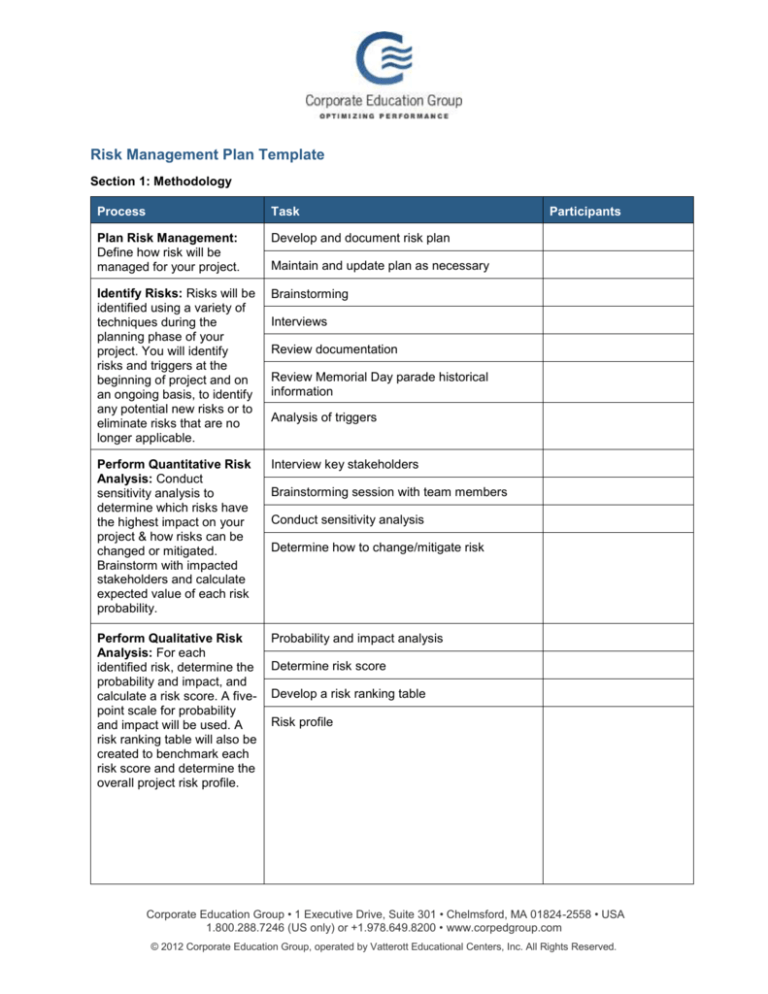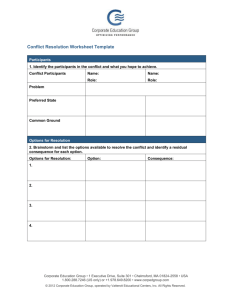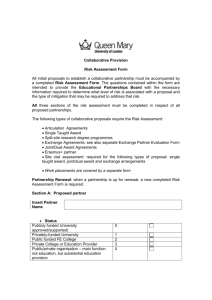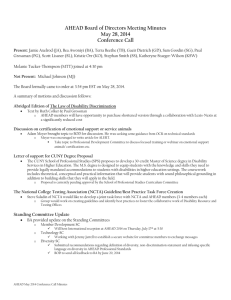
Risk Management Plan Template
Section 1: Methodology
Process
Task
Plan Risk Management:
Define how risk will be
managed for your project.
Develop and document risk plan
Identify Risks: Risks will be
identified using a variety of
techniques during the
planning phase of your
project. You will identify
risks and triggers at the
beginning of project and on
an ongoing basis, to identify
any potential new risks or to
eliminate risks that are no
longer applicable.
Brainstorming
Perform Quantitative Risk
Analysis: Conduct
sensitivity analysis to
determine which risks have
the highest impact on your
project & how risks can be
changed or mitigated.
Brainstorm with impacted
stakeholders and calculate
expected value of each risk
probability.
Interview key stakeholders
Perform Qualitative Risk
Analysis: For each
identified risk, determine the
probability and impact, and
calculate a risk score. A fivepoint scale for probability
and impact will be used. A
risk ranking table will also be
created to benchmark each
risk score and determine the
overall project risk profile.
Probability and impact analysis
Participants
Maintain and update plan as necessary
Interviews
Review documentation
Review Memorial Day parade historical
information
Analysis of triggers
Brainstorming session with team members
Conduct sensitivity analysis
Determine how to change/mitigate risk
Determine risk score
Develop a risk ranking table
Risk profile
Corporate Education Group • 1 Executive Drive, Suite 301 • Chelmsford, MA 01824-2558 • USA
1.800.288.7246 (US only) or +1.978.649.8200 • www.corpedgroup.com
© 2012 Corporate Education Group, operated by Vatterott Educational Centers, Inc. All Rights Reserved.
Process
Task
Plan Risk Response: For
each identified risk, assign a
risk owner to have primary
responsibility of mitigating
that risk. The risk owner is
also responsible for
developing a risk response
plan and contingency plan,
in the event that the risk
response fails or does not
mitigate the risk to the
acceptable threshold level.
Assign risk owners
Monitor and Control
Risks: All identified risks
will be documented and
scored, then prioritized
based on risk score. All risks
rated high or very high will
be reviewed daily; medium
rated risks will be reviewed
weekly. Any risk triggers that
take effect should be
brought to the attention of
the project manager ASAP.
Participants
Develop a response strategy
Develop a contingency strategy
Review and update strategy as needed
Daily review of high and very high risks
Weekly review of medium risks
Report risk triggers change to Project Manager
Section 2: Roles and Responsibilities
Role
Responsibilities
Project Manager
Team Member Assigned to
Manage a Risk
Internal Stakeholders
External Stakeholders
Corporate Education Group • 1 Executive Drive, Suite 301 • Chelmsford, MA 01824-2558 • USA
1.800.288.7246 (US only) or +1.978.649.8200 • www.corpedgroup.com
© 2012 Corporate Education Group, operated by Vatterott Educational Centers, Inc. All Rights Reserved.
Section 3: Budgeting
Risk Management Activities
Activity
Budget
Contingency Reserves
Description
Budget
Section 4: Timing
Activity
Phase/Date
Corporate Education Group • 1 Executive Drive, Suite 301 • Chelmsford, MA 01824-2558 • USA
1.800.288.7246 (US only) or +1.978.649.8200 • www.corpedgroup.com
© 2012 Corporate Education Group, operated by Vatterott Educational Centers, Inc. All Rights Reserved.
Section 5: Risk Categories
Once all risks have been identified, develop risk categories to logically organize the risks. The categories
of risk are (but not limited to):
Technical
Organizational
External
Project Management
Environmental
Communications
Safety
Scope
Time
Cost
Quality Requirements
Resource Availability
Labor Availability
This list should not preclude the creation of additional categories, if project risks merit new categories.
Section 6: Definitions of Risk Probability and Impact
Probability
Very Low
Low
Moderate
High
Very High
Impact
Project
Objective
Very Low
Low
Moderate
High
Very High
Cost
Time
Scope
Quality
Corporate Education Group • 1 Executive Drive, Suite 301 • Chelmsford, MA 01824-2558 • USA
1.800.288.7246 (US only) or +1.978.649.8200 • www.corpedgroup.com
© 2012 Corporate Education Group, operated by Vatterott Educational Centers, Inc. All Rights Reserved.
Section 7: Probability and Impact Matrix
Risk Rating List
Value
of P
Value
of I
Risk Score
Risk Description
Risk Rating
Risk Response
Strategy
Probability and Impact Matrix
Probability
Threats
Opportunities
Section 8: Revised Stakeholders’ Risk Tolerances
Stakeholder
Normal Risk Tolerance
Current Project Risk Tolerance
Corporate Education Group • 1 Executive Drive, Suite 301 • Chelmsford, MA 01824-2558 • USA
1.800.288.7246 (US only) or +1.978.649.8200 • www.corpedgroup.com
© 2012 Corporate Education Group, operated by Vatterott Educational Centers, Inc. All Rights Reserved.
Section 9: Reporting Formats (with Example Content)
Report
Format
Risk Register/Database
Risk ID, risk category, risk description, risk originator, risk owner, last
updated, probability score, impact score, risk score, risk status (new,
open, mitigation plan created, mitigation plan approved, completed, reopened),trigger, mitigation strategy, contingency strategy
High Risk Report (daily)
Only high or very high risks reported - risk ID, risk category, risk
description, risk originator, risk owner, last updated, probability score,
impact score, risk score, risk status (new, open, mitigation plan created,
mitigation plan approved, completed, re-opened),trigger, mitigation
strategy, contingency strategy.
Weekly Risk Report
Only medium risks reported - risk ID, risk category, risk description, risk
originator, risk owner, last updated, probability score, impact score, risk
score, risk status (new, open, mitigation plan created, mitigation plan
approved, completed, re-opened),trigger, mitigation strategy,
contingency strategy
Section 10: Tracking
Process
Auditing Procedure
Plan Risk Management
Identify Risks
Perform Qualitative Risk
Analysis
Perform Quantitative Risk
Analysis
Plan Risk Responses
Monitor and Control Risks
Independent auditor, contracted by Citizens Collaborative BOD, to
review the plan and present findings to Sponsor and Citizen
Collaborative BOD for follow up and corrective action
Independent auditor, contracted by Citizens Collaborative BOD, to
review the Identify Risks process and present findings to Sponsor
and Citizen Collaborative BOD for follow up and corrective action
Independent auditor, contracted by Citizens Collaborative BOD, to
review the qualitative risk analysis process and present findings to
Sponsor and Citizen Collaborative BOD for follow up and corrective
action
Independent auditor, contracted by Citizens Collaborative BOD, to
review the Perform Quantitative Risk Analysis process and present
findings to Sponsor and Citizen Collaborative BOD for follow up and
corrective action
Independent auditor, contracted by Citizens Collaborative BOD, to
review the Risk Response plan and present findings to Sponsor and
Citizen Collaborative BOD for follow up and corrective action
Independent auditor, contracted by Citizens Collaborative BOD, to
review the Monitoring and Control process and present findings to
Sponsor and Citizen Collaborative BOD for follow up and corrective
action
Extracted from MDP273a: Project Risk Management
Corporate Education Group • 1 Executive Drive, Suite 301 • Chelmsford, MA 01824-2558 • USA
1.800.288.7246 (US only) or +1.978.649.8200 • www.corpedgroup.com
© 2012 Corporate Education Group, operated by Vatterott Educational Centers, Inc. All Rights Reserved.







